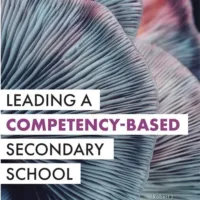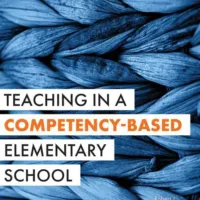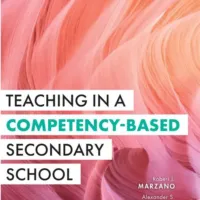
Can learners provide evidence of the Scale Level 3.0 if they can’t show all Scale Level 2.0 without error?
The short answer is YES.
When implementing Competency-based education, it is natural to think about learning as a staircase that progresses in even steps to cover the gap between where a student is currently independent in their thinking and where they can reach with the support of the teacher – or other more knowledgeable individuals like classmates, older mentor students, or community experts. This gap is known as the Zone of Proximal Development. It is a theory put forth by the educational psychologist Lev Vygotsky (Link). In order to move to this new level of independent thinking, a learner needs to acquire additional knowledge. This foundational knowledge is represented in the Scale Level 2.0 of a proficiency scale.
It is, therefore, easy to conclude that for a learner to be competent, they need all of those “steps” or chunks if they are going to be able to apply them and demonstrate they understand the concept or execute the strategy that is found at the Scale Level 3.0 and 4.0 of the proficiency scale. The problem is that learning is not always sequential. The path does not always progress in front of us in a consistent and straightforward process. Progress towards understanding can meander. The students seem to have the foundational knowledge one day, but when needed in a few days to answer a question, it seems to have vanished from memory.
It might help to think of learning not as a sequential set of steps that one needs to walk up to get to a higher level of understanding. But instead, as a tide coming in on a beach. The ocean will touch upon parts of the beach as the waves ebb and flow. A large wave may touch a grain of sand, getting it wet, but it will become dry if not touched upon again. However, water will eventually cover the beach as the tide moves in. All grains of sand will now remain wet, given the change in circumstance. The same is true for students’ knowledge. As teachers touch upon the grains of information (facts, skills, data, etc.), the learners will enter them into their working
memories. As the lesson ebbs and flows, some grains will not stay wet long and eventually dry up and be lost before they become embedded as new knowledge. Eventually, the tide will come in, and the learner will have the grain of knowledge entered into the ocean of long-term memory where it can be retrieved and used – as long as we continue to touch upon the previously integrated knowledge from time to time. A process we call cumulative review. (see the blog on Cumulative Review.)
So, getting back to the original question, it is not helpful to think about needing all of the Scale Level 2.0 before being able to answer Scale Level 3.0. While we want to track students’ progress through acquiring the foundational knowledge they will need to retrieve and demonstrate that they understand the concept or can execute the skill without error, it can be challenging. Sometimes, answering the more cognitively engaging question solidifies the foundational knowledge and deepens the thinking. Referring back to our metaphor, the tide has entered the grain of information into the ocean of knowledge. If we waited until the students walked up the stairs and ensured each step was solid, the learner might never have had the ah-ha moment and only see the information as discrete steps rather than as a more profound concept. This more engaging question acted like a wave and pushed the water further up the beach making it possible for the grain of information to be added to the ocean of knowledge.
Suppose students can answer an assessment question or project prompt designed to provide evidence of the Scale Level 3.0 learning target without using the foundational knowledge. In that case, there is an issue with your question. For example, if a student can answer a high school biology question using information they remember from 7th grade, we have yet to step up the complexity of the question. Chances are the Scale Level 2.0 foundational knowledge we were providing through our daily direct instruction activities was the same as what they were already exposed to in earlier grades. The Scale Level 2.0 foundational knowledge should bridge the gap between what they were expected to understand in 7th grade independently and what they are now expected to understand in high school biology. Then when we design a task to assess this new level of understanding, they should need to retrieve the newly acquired knowledge, which was added to what they already knew through the process of cumulative review, to answer it. If they do not need to use the new knowledge and can rely solely on the old knowledge, the question is not assessing the concept at the correct level of cognitive complexity and should be tweaked or not used.
To summarize, the Zone of Proximal Development is real. It is the gap between what learners know about a concept and what they can know with the support of a more knowledgeable other. The gap can be bridged by considering the new foundational knowledge necessary for the learners to get to a new level of independent thinking. That new knowledge is placed in the Scale Level 2.0 of your proficiency scale. Then we help the learners track their progress keeping in mind that they can take shots at the Scale Level 3.0 demonstrations before having all the Scale level 2.0 “checked off.” If your learners can answer your Scale Level 3.0 questions without properly applying the retrieved, recently acquired Scale Level 2.0 foundational knowledge, something is wrong with your assessment question and needs to be adjusted.
So, the question is, can the learners answer the 3.0 question without needing the Scale Level 2.0? If yes. Toss it out. If no, did they answer the question correctly? If yes, they earn a score of 3.0 regardless of how they did with other questions that only targeted Scale Level 2.0. The goal is not to create a massive checklist of foundational knowledge, and skills learners must move through to be determined proficient. The learning goal is the Scale Level 3.0 target statement. Suppose they are struggling to demonstrate understanding or skill at the proficient level. In that case, we can use our scales to determine which of the foundational pieces are missing or which they have a misconception about preventing them from proficient thinking. That is the key to using the scale for assessment.
Resources:
Vygotsky L. S., Cole, M., Stein, S., & Sekula, A. (1978). Mind in society: The development of Higher Psychological Processes. Harvard University Press.
Marzano, R., Norford, J., Ruyle, M., 2018. The new art and science of classroom assessment. Bloomington: Solution Tree.





